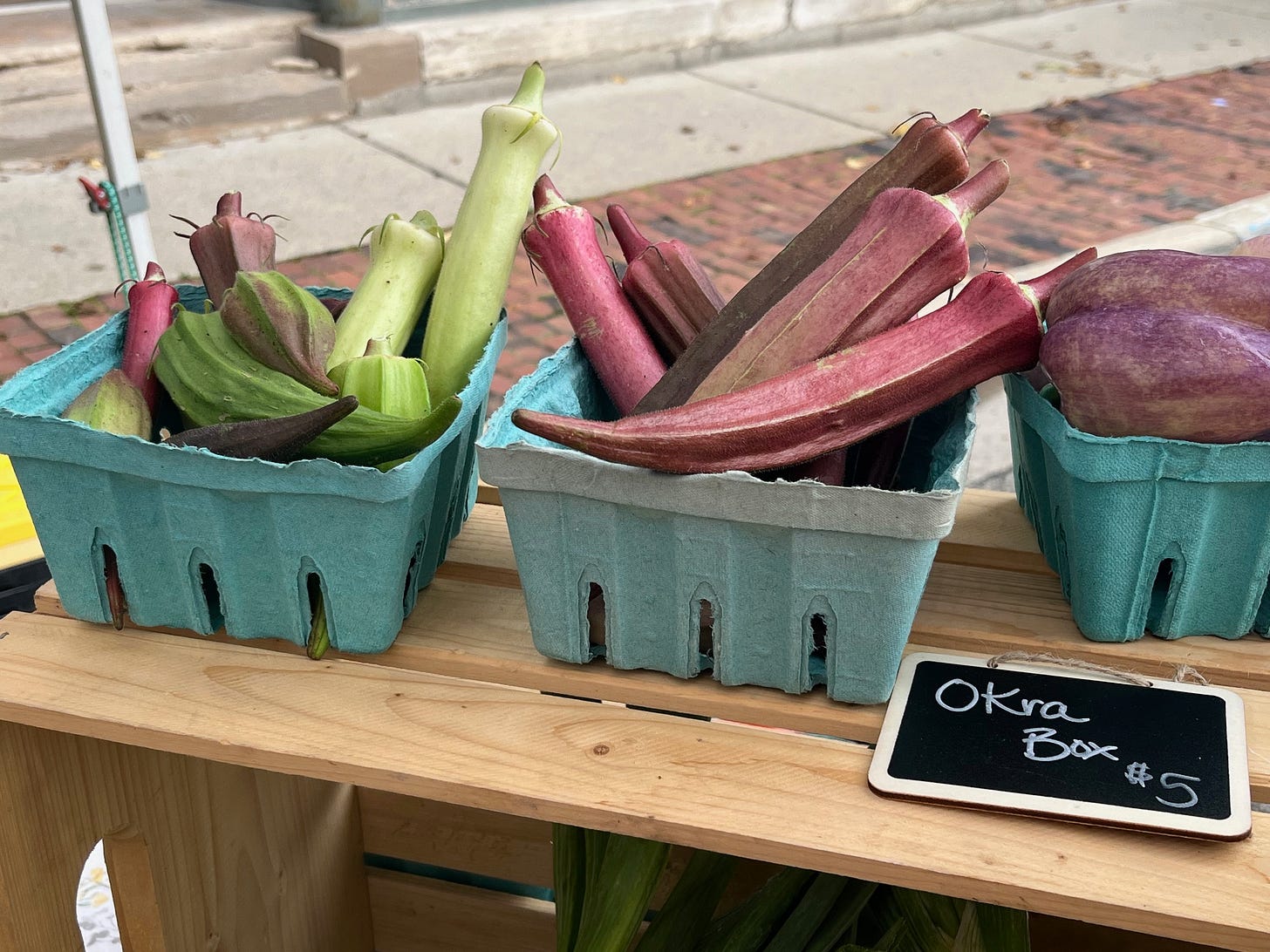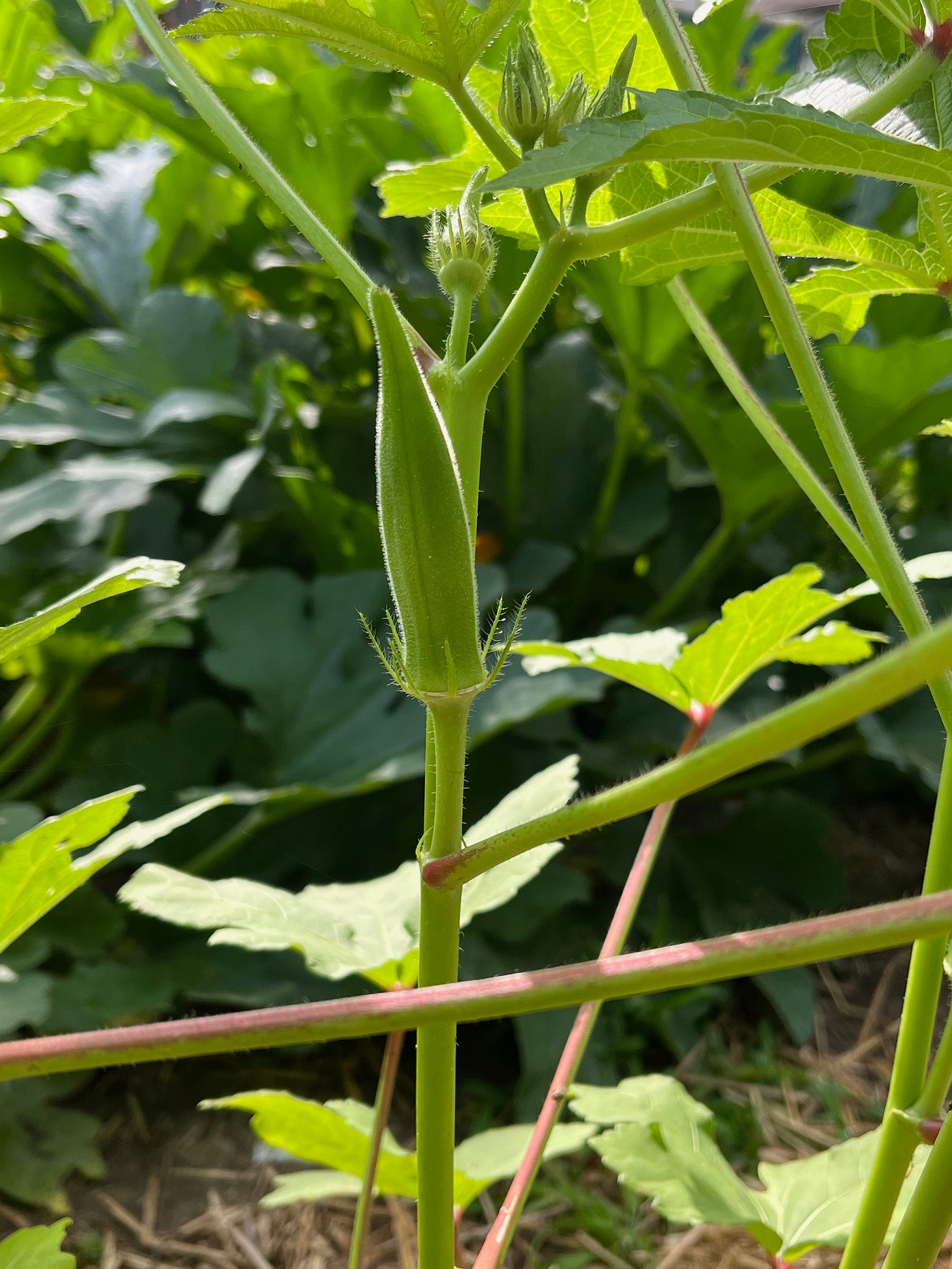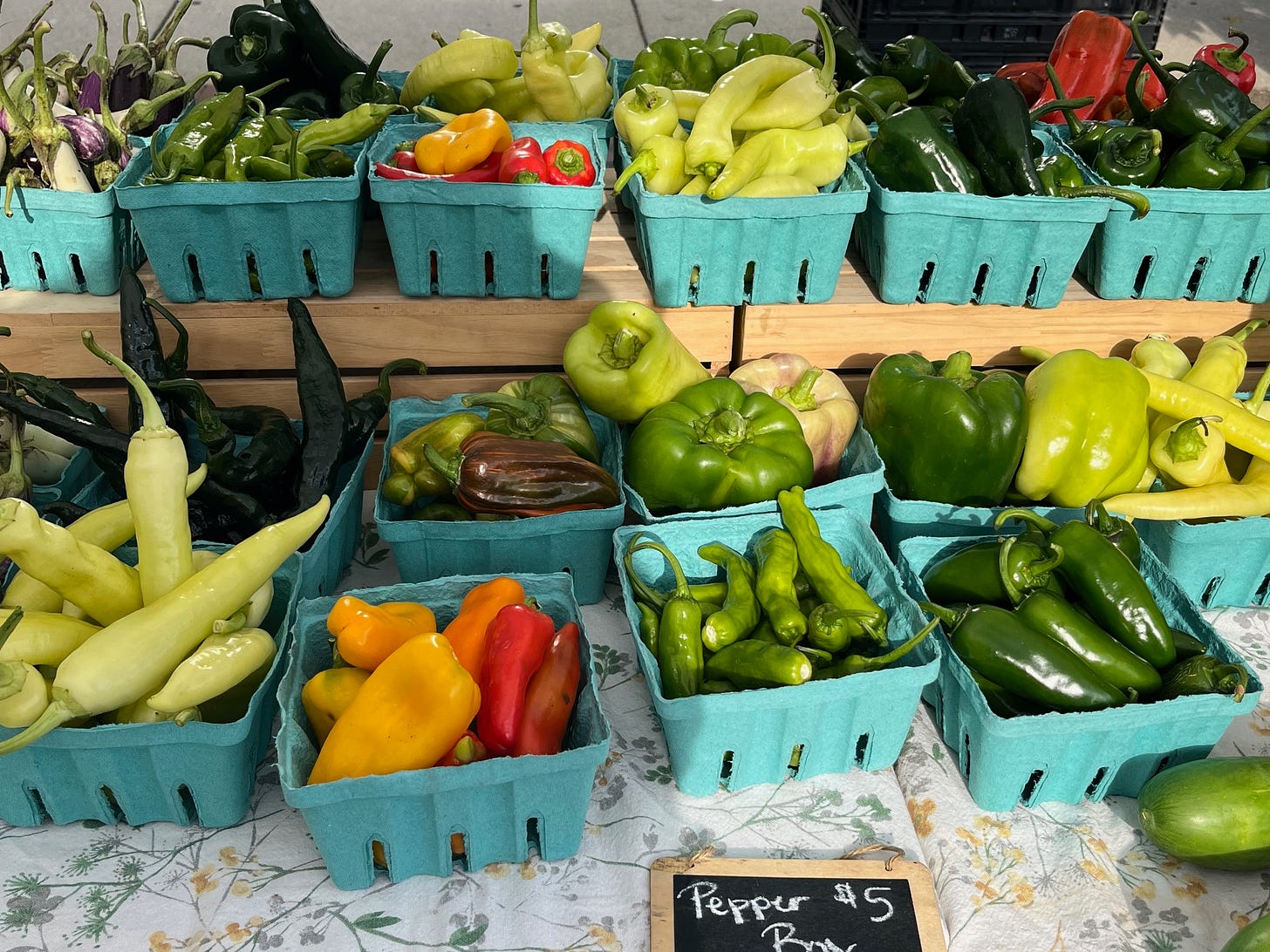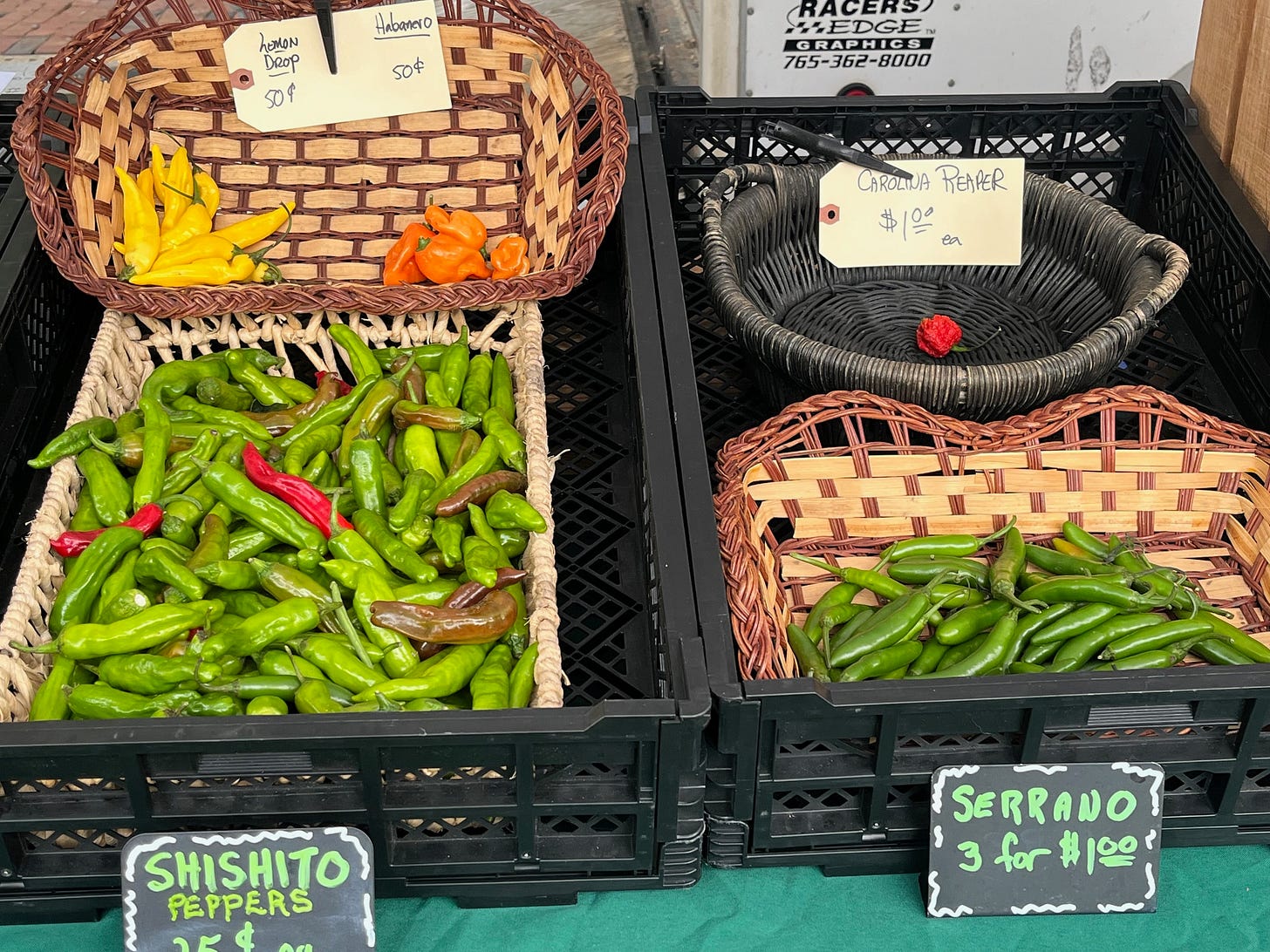Market Report: Slimy pods and five-alarm peppers
What’s hot, and not so hot, at the farmers markets this week. Starting with: Defending the honor of okra.
Support for this edition comes from the West Lafayette Public Library Foundation, which will host an ice cream social fundraiser from 1-3 p.m. Saturday, Aug. 16, at the Caretaker’s Cottage, 1496 N. Salisbury St. Donations from the pay-what-you-wish event will support the 1903 cottage next to the Grand View Cemetery, which the library leases from the city as its local history center. The Bum Ditty Barn Dance Band will play on the back porch from 1-2 p.m., followed by the Wabash Valley Youth Symphony string quartet from 2-3 p.m. Learn more here: www.wlplf.org/30years.
And now, what’s hot, and not so hot, at the farmers markets this week …
By Carol Bangert / For Based in Lafayette
My mother was a proud Texan who maintained her Southern drawl after nearly 60 years of Hoosier living. She had strong beliefs and traditions that she brought north with her, and I bought into virtually everything she told me – except for her adamant belief that the Dallas Cowboys were “God’s Team.” Many of the things she shared with me were not opinions; they were declarations, and she set her own rules. She played croquet barefoot, never ate mayonnaise on a hot sandwich and told me to always leave a little food on my plate when I ate at a friend’s house – that way the host would know I’d had enough to eat (even if I hadn’t).
Mom told me that okra was only eaten in gumbo, never on its own. “Disgusting!” she declared, citing its slimy insides and fuzzy pods. She recalled as a child trying to sneak okra under the table to her dog and that even the dog wouldn’t touch it. So, I believed her. I had no reason not to – back then, okra wasn’t found in the produce section of Lafayette grocery stores. I didn’t even know what okra looked like “in the wild;” I’d only seen it sliced, floating around in a beautiful mahogany bowl of shrimp gumbo, where it seemed harmless enough. Imagine my surprise when I started seeing okra pop up in cookbooks and recipes, not as an ingredient, but as the star of the show. “Disgusting,” I told myself, conjuring my Mom’s Texas accent.
But despite my objections, okra is trendy, so I decided to give this little pod a chance. They are fuzzy and sticky and the insides have been described as slimy, gooey and (my favorite) mucousy. Makes you want to dive right in, doesn’t it? I wasn’t going to let that stop me, and I bought a box of okra at a recent farmers market. But that’s where it ended. I didn’t know what to do next.
Luckily, I didn’t have to go far for good advice and cooking methods. A few mornings a week I volunteer with GrowLocal, an urban garden network that grows produce to help ease food insecurity and build community here in Lafayette (growlocallafayette.org/), and okra is one of the vegetables grown in the nearly 10 plots – along with cabbage, kohlrabi, rutabaga, tomatoes, peppers, eggplant and squash. Over the last few months, I’ve watched tiny okra starts grow into plants sporting beautiful fan-shaped leaves with a burgundy center, and white/pale yellow flowers that produce bright green pods ready for the picking. Harry Smith, the urban gardener I work with, says okra is best picked at about thumb size, and during a recent work session at one of the gardens, I watched in horror as Smith picked an okra pod from the plant and ATE IT! RAW!
“The key,” he said, “is to eat it quickly in one or two bites.” I mustered up the courage and ate a pod, expecting something, well, disgusting. But okra has a pleasant taste and reminds me of green beans. Though I wouldn’t recommend beginning your okra journey the way I did, it did show me that okra is edible – even tasty – raw.
A handful of farmers at the markets are growing and selling okra and offer these simple ways to use the pods: roast or grill them with olive oil, salt and pepper; batter them in tempura batter and fry; sauté with garlic; stew with bacon, onions and tomatoes. Of course, you can always slice those pods up to thicken and flavor a nice pot of gumbo.
When you buy okra (if this report hasn’t scared you off), store the unwashed pods in a bag in the fridge. They’ll only last a few days, so get cooking!
Peppers, peppers and more peppers
After returning from the market a few weeks ago, I said to my husband, “Is there anything prettier in nature right now than the color of peppers?” I’m still waiting for his response.
Whether you like the taste of peppers – hot, sweet or neutral – you have to admit that they are visually stunning. Spectacular reds and oranges, purples and yellows, greens of every shade, stripes. But those colors can be ruthlessly deceiving. Bell peppers are one thing; but hot peppers can bring you to your knees if you’re not careful.
I’ve met a lot of people who don’t like peppers, but I would urge them to give them another try. Sweet/bell peppers have subtle flavor differences depending on their color, but all are great eaten raw, and they play a key role in stir fries and fajitas, soups and stews. Green peppers, in particular, are great for stuffing with just about anything you like.
Hot/chile peppers are an entirely different animal and range in heat from pleasantly spicy to I-just-ate-a-volcano hot. Back in the 1980s when I lived in New Mexico, the Hatch chile was considered one of the hottest varieties around, and I loved them. I still do. The chile is quite hot but not crippling. By today’s standards, though, the Hatch chile is a wimp, with new varieties getting progressively hotter. (Check out the pepper chart at Wabash & Riley’s booth that outlines Scoville Heat Units.)
I no longer eat foods that punch me in the face, and I avoid the super-hot chile varieties – do I really need to eat something called the Carolina Reaper? That’s a hard no. But chiles add flavor and depth to recipes, and a well-made chiles rellenos can’t be beat. If you are the adventurous type, the farmers market is a great place to experiment with chiles of different heat levels, where vendors are selling an impressive array right now.
I bought a box of multi-colored mini bell peppers and a handful of bright green shishitos and enjoyed them both: The mini bells raw with hummus and the shishitos roasted with olive oil, salt and pepper. The two varieties offer a nice illustration of what peppers can offer this time of year.
Store peppers of any variety in the refrigerator if you’re not using them in a day or so. Peppers also freeze well.
The takeaway from this Market Report is simple: Lurking among the sweet corn, tomatoes and squash is some lovely, perhaps misunderstood, produce that is definitely worth a look.
Other mid-August fruits and vegetables at the market include:
Cabbage
Cucumbers
Red and yellow onions
Garlic
Select greens
Green beans
Herbs
Carrots
Okra
Peppers: Sweet and hot varieties
Potatoes
Eggplant
Sweet corn
Zucchini, zucchini blossoms, summer squash and other squash varieties
Tomatoes of all shapes and sizes
Raspberries, blackberries, blueberries
Cherries, peaches, plums, apricots (from Michigan and Georgia)
For more about GrowLocal: For more information about the gardens and getting involved with GrowLocal – a network of gardeners across Greater Lafayette devoted to building, nourishing and nurturing our community through the growth of urban gardens – go to growlocallafayette.org.
DAYS/HOURS FOR THE MARKETS
West Lafayette Farmers Market: 3:30-7:30 p.m. Wednesdays, through October. This year marks the 20th anniversary of the West Lafayette market. The market is held at Cumberland Park in West Lafayette with more than 50 vendors.
Lafayette Farmers Market: 8 a.m.-12:30 p.m. Saturdays, through October, on Fifth Street between Columbia Street and mid-block to Ferry Street, and Main Street between Fourth and Sixth streets.
Purdue Farmers Market: 11 a.m.-3 p.m. Thursdays, through October. The Purdue Farmers Market is held on the Memorial Mall on Purdue’s campus. This market is a concession-heavy market that allows students, faculty and staff to have lunch options in a unique outdoor setting.
Carol Bangert, editor of Greater Lafayette Magazine, has been a regular at Greater Lafayette farmers markets for more than 20 years. From May through October, she’ll scout out in-season produce at the markets and report back on fresh finds and how to use them.
Thanks, again, for support for this edition from the West Lafayette Public Library Foundation, hosting an ice cream social fundraiser from 1-3 p.m. Saturday, Aug. 16, at the Caretaker’s Cottage, 1496 N. Salisbury St. Learn more here: www.wlplf.org/30years.
Thank you for supporting Based in Lafayette, an independent, local reporting project. Free and full-ride subscription options are ready for you here.
Tips, story ideas? I’m at davebangert1@gmail.com.









I'm having trouble getting poblanos with a consistent heat. Some are like bell peppers with a mildly bratty attitude, some clear the house like a chemical grenade when I blacken them. I grew up eating these things so it seems less likely that I mistook a large jalapeño for one.
I had been wondering if Hatches used to be hotter. I used to love seeing the red bunches drying in that punishing sun, with a too-perfect resemblance to strings of firecrackers.
In the South we cut okra into small discs, bread the discs in corn meal and then fried. The best cooks can get it crispy but also moist on the inside. You will find fried okra in soul food restaurants and on a list of vegetables offered in plate lunch restaurants. Okra in gumbo-mandatory. Boiled okra-not good.